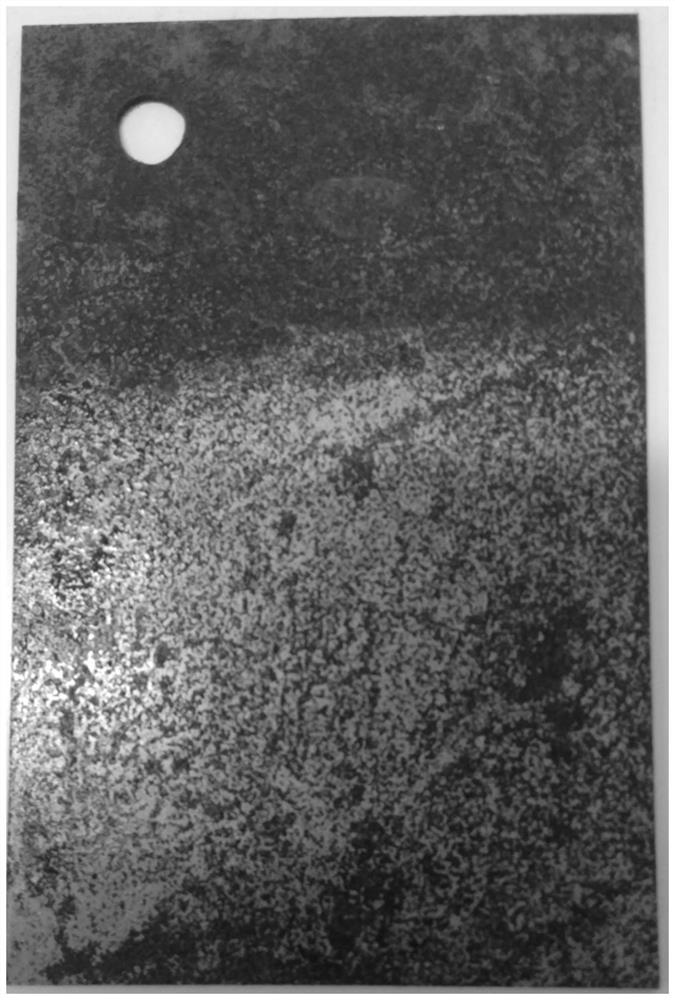A boron sulfate rust remover
A technology of borosulfate and rust remover, which is applied in the field of borosulfate rust remover, can solve problems affecting steel strength, hydrogen embrittlement, economic loss, etc., and achieve the effect of strong rust removal ability
- Summary
- Abstract
- Description
- Claims
- Application Information
AI Technical Summary
Problems solved by technology
Method used
Image
Examples
Embodiment 1
[0023] A borosulfate rust remover, the preparation steps are as follows:
[0024] (1) Put 50 parts of nonylphenol into the reaction kettle, heat to 100°C, then slowly add 1 part of boric acid, and react for 140 minutes after the addition;
[0025] (2) After the reaction is completed, the temperature is lowered to 60° C., 2 parts of auxiliary agent sorbitol are added, and the temperature is naturally lowered to normal temperature;
[0026] (3) Slowly add 1 part of S under 0.1Pa pressure 2 o 3 , stirring while adding, after the addition, the temperature was raised to 50°C, and the reaction was carried out for 180 minutes;
[0027] (4) After the reaction is completed, cool down to below 50°C, add 2 parts of sorbitol as an auxiliary agent, react for 100 minutes, and then naturally cool down to below 30°C to obtain the product.
Embodiment 2
[0029] A borosulfate rust remover, the preparation steps are as follows:
[0030] (1) Put 60 parts of nonylphenol polyoxyethylene ether NP-10 into the reactor, heat to 120°C, then slowly add 8 parts of boric acid, and react for 140 minutes after the addition;
[0031] (2) After the reaction is completed, the temperature is lowered to 60° C., 2 parts of auxiliary agent glycerol is added, and the temperature is naturally lowered to normal temperature;
[0032] (3) Slowly add 1 part of S under the pressure of 0.5Pa 2 o 3 , Stir while adding, keep the temperature at 25-30°C during the stirring process; raise the temperature to 60°C after the addition, and react for 150 minutes;
[0033] (4) After the reaction is completed, the temperature is lowered to below 50°C, 2 parts of auxiliary agent glycerol is added, and the reaction is carried out for 120 minutes, and then the temperature is naturally lowered to below 30°C to obtain the product.
Embodiment 3
[0035] A borosulfate rust remover, the preparation steps are as follows:
[0036] (1) Put 100 parts of nonylphenol polyoxyethylene ether NP-20 into the reactor, heat to 150°C, then slowly add 15 parts of boric acid, and react for 100 minutes after the addition;
[0037] (2) After the reaction is completed, the temperature is lowered to 100° C., 12 parts of auxiliary agent mannitol is added, and the temperature is naturally lowered to normal temperature;
[0038] (3) Slowly add 5 parts of SO under 10Pa pressure 3 , stirring while adding, after the addition, the temperature was raised to 90°C, and the reaction was carried out for 100 minutes;
[0039] (4) After the reaction is completed, the temperature is lowered to below 50°C, 10 parts of auxiliary agent xylitol is added, reacted for 150 minutes, and then the temperature is naturally lowered to below 30°C to obtain the product.
PUM
 Login to View More
Login to View More Abstract
Description
Claims
Application Information
 Login to View More
Login to View More - R&D
- Intellectual Property
- Life Sciences
- Materials
- Tech Scout
- Unparalleled Data Quality
- Higher Quality Content
- 60% Fewer Hallucinations
Browse by: Latest US Patents, China's latest patents, Technical Efficacy Thesaurus, Application Domain, Technology Topic, Popular Technical Reports.
© 2025 PatSnap. All rights reserved.Legal|Privacy policy|Modern Slavery Act Transparency Statement|Sitemap|About US| Contact US: help@patsnap.com


